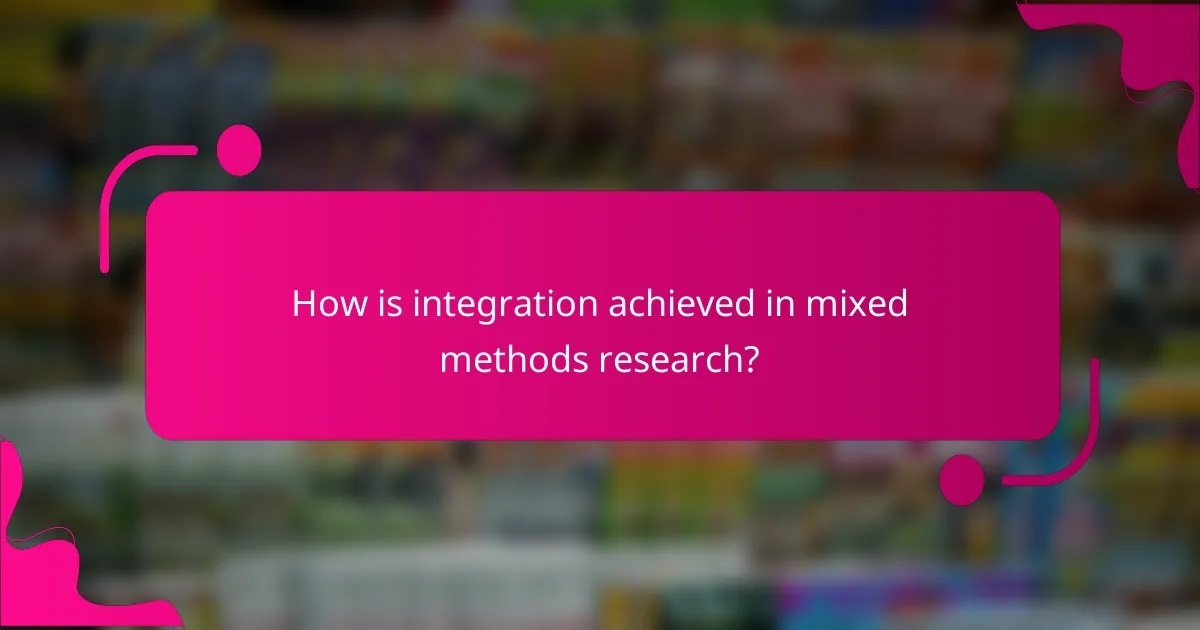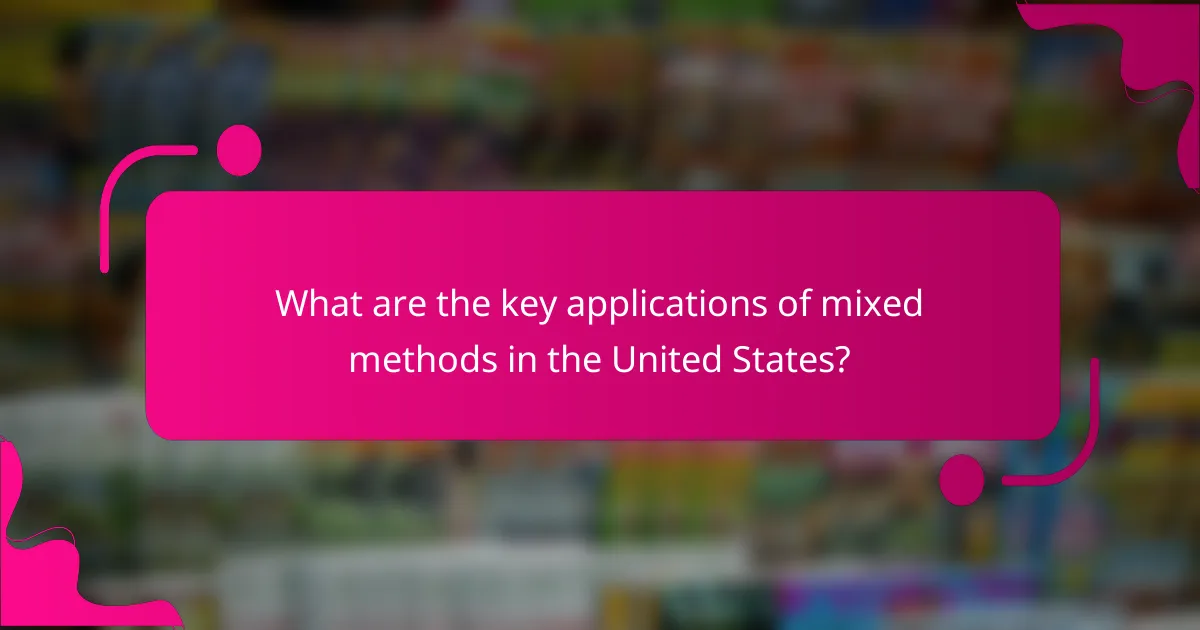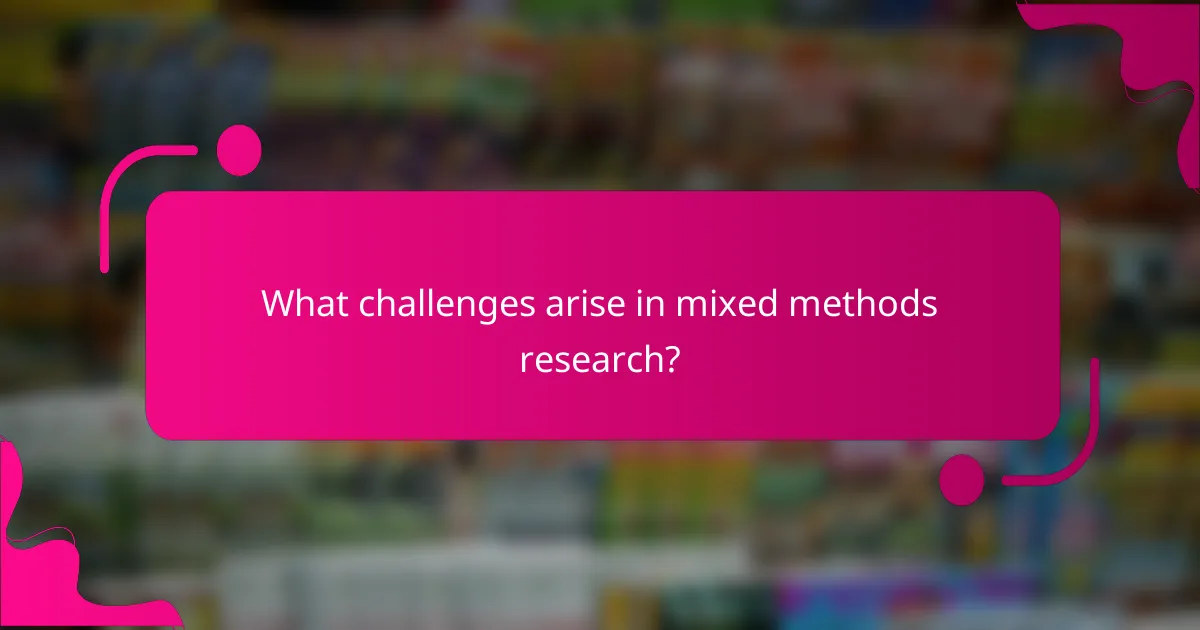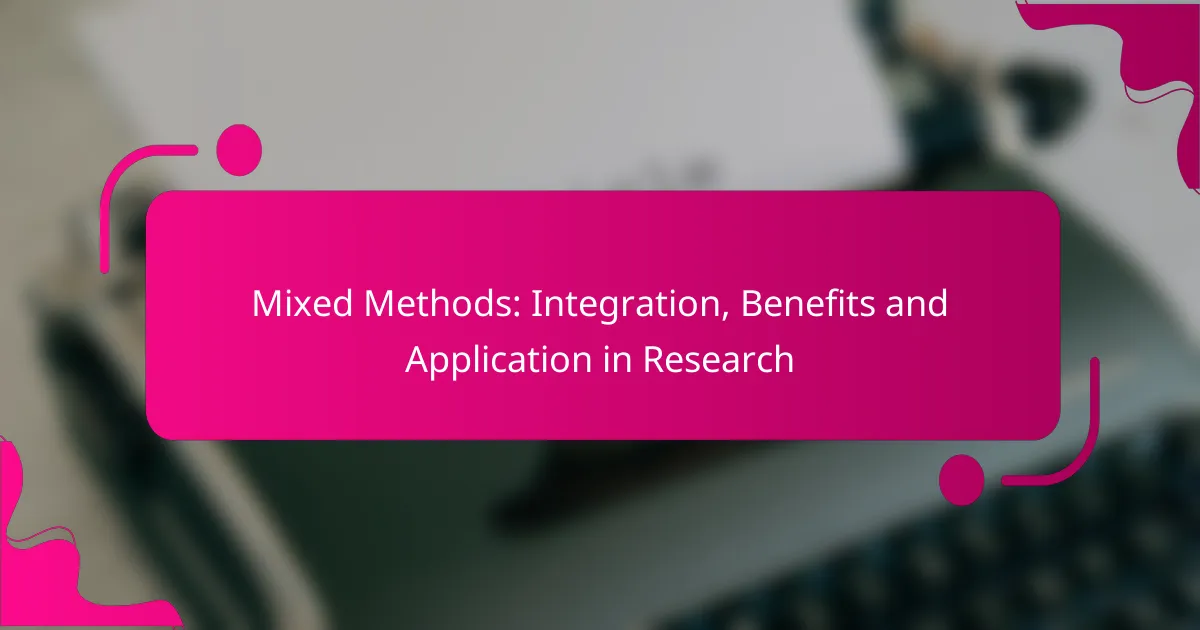Mixed methods research integrates qualitative and quantitative approaches, providing a robust framework for exploring complex issues. By combining different data types, researchers can enhance validity, improve participant engagement, and achieve a more comprehensive understanding of their research problems. This methodology is particularly beneficial across various fields, allowing for richer insights and more effective solutions.

What are the benefits of mixed methods in research?
Mixed methods in research combine qualitative and quantitative approaches, offering several advantages. These benefits include enhanced data triangulation, a comprehensive understanding of complex issues, increased validity and reliability, improved participant engagement, and flexibility in research design.
Enhanced data triangulation
Mixed methods allow researchers to validate findings by cross-verifying data from multiple sources. This triangulation helps to ensure that results are not biased or skewed by relying solely on one type of data. For instance, a study on educational outcomes might combine test scores (quantitative) with student interviews (qualitative) to provide a fuller picture.
By integrating different data types, researchers can identify patterns and discrepancies, leading to more robust conclusions. This approach is particularly useful in fields like social sciences, where complex human behaviors are studied.
Comprehensive understanding of complex issues
Using mixed methods enables researchers to explore multifaceted problems more thoroughly. Qualitative data can reveal the context and motivations behind quantitative trends, leading to deeper insights. For example, in health research, statistical data on disease prevalence can be enriched by patient narratives that explain their experiences.
This comprehensive understanding is crucial for addressing issues that cannot be fully captured by numbers alone. It allows researchers to consider various perspectives and factors influencing the subject matter.
Increased validity and reliability
Mixed methods enhance the validity and reliability of research findings by combining the strengths of both qualitative and quantitative approaches. Quantitative data provides statistical rigor, while qualitative insights add depth and context. This combination reduces the likelihood of errors and biases that may arise from using a single method.
For example, a survey might quantify customer satisfaction, while follow-up interviews explore the reasons behind those satisfaction levels. This layered approach increases confidence in the results and their applicability in real-world scenarios.
Improved participant engagement
Incorporating mixed methods can lead to higher participant engagement, as it allows for varied forms of interaction. Participants may feel more comfortable sharing their thoughts in interviews or focus groups than through surveys alone. This engagement can lead to richer data and a more authentic representation of their views.
For instance, in community-based research, using both surveys and community forums can encourage broader participation and more diverse input, enhancing the overall quality of the research.
Flexibility in research design
Mixed methods offer flexibility in research design, allowing researchers to adapt their approach based on emerging findings. This adaptability can be particularly beneficial in exploratory studies where initial results may lead to new questions or areas of inquiry. Researchers can pivot between qualitative and quantitative methods as needed.
For example, if a quantitative survey reveals unexpected trends, researchers can conduct qualitative interviews to explore those trends further. This iterative process can lead to more nuanced and insightful research outcomes.

How is integration achieved in mixed methods research?
Integration in mixed methods research is achieved by combining qualitative and quantitative data to provide a comprehensive understanding of a research problem. This process involves strategically aligning different data types to enhance the overall findings and insights.
Sequential integration
Sequential integration involves collecting and analyzing one type of data before the other, allowing researchers to use the results of the first phase to inform the second. For example, qualitative interviews may be conducted first to explore themes, followed by a quantitative survey that tests those themes on a larger scale. This approach can provide depth and context to the quantitative findings.
When using sequential integration, it’s crucial to clearly define the research questions for each phase and ensure that the transition between phases is logical and coherent. Researchers should also consider the time and resources required for each stage.
Concurrent integration
Concurrent integration occurs when qualitative and quantitative data are collected simultaneously, allowing for real-time comparison and analysis. This method can be particularly effective in studies where immediate feedback is necessary, such as in program evaluations or action research. For instance, conducting focus groups while administering surveys can yield insights that enhance both data sets.
To successfully implement concurrent integration, researchers should ensure that the data collection methods are compatible and that they have a clear plan for how to merge the findings. This approach can save time but may require more complex analysis to reconcile differing data types.
Data transformation techniques
Data transformation techniques involve converting qualitative data into quantitative formats or vice versa to facilitate integration. For example, qualitative themes can be quantified by counting the frequency of specific responses, allowing for statistical analysis. Alternatively, quantitative data can be enriched with qualitative insights to provide context.
When applying data transformation, researchers should be cautious about losing the richness of qualitative data or oversimplifying complex quantitative results. Clear documentation of the transformation process is essential to maintain transparency and validity.
Utilizing software tools like NVivo
Software tools such as NVivo can significantly enhance the integration of mixed methods research by providing platforms for organizing, analyzing, and visualizing data. NVivo allows researchers to code qualitative data and link it with quantitative datasets, making it easier to identify patterns and relationships.
To maximize the benefits of software tools, researchers should invest time in training and familiarize themselves with the features that best suit their integration needs. Regularly updating the software and utilizing its collaborative features can also improve efficiency and data management.

What are the key applications of mixed methods in the United States?
Mixed methods research combines qualitative and quantitative approaches, making it particularly useful in various fields across the United States. This approach allows researchers to gain comprehensive insights by triangulating data, enhancing the validity of their findings.
Social science research
In social science research, mixed methods facilitate a deeper understanding of complex social phenomena. By integrating surveys (quantitative) with interviews or focus groups (qualitative), researchers can explore not only what people think but also why they hold those beliefs. This dual approach can uncover patterns and motivations that might be missed with a single method.
For example, a study on community engagement might use statistical analysis to measure participation rates while also conducting interviews to understand the barriers to involvement. This combination provides a fuller picture of the social dynamics at play.
Healthcare studies
Mixed methods are increasingly applied in healthcare studies to evaluate interventions and understand patient experiences. Quantitative data can reveal trends in health outcomes, while qualitative insights can explain the context behind those trends. This is particularly valuable in understanding patient adherence to treatment plans.
For instance, a study on diabetes management might analyze blood sugar levels (quantitative) alongside patient interviews to identify challenges in lifestyle changes. Such insights can inform more effective healthcare strategies tailored to patient needs.
Education assessments
In education assessments, mixed methods can enhance the evaluation of teaching effectiveness and student learning outcomes. Quantitative assessments, such as standardized test scores, can be complemented with qualitative feedback from students and teachers to provide a richer understanding of educational practices.
For example, a school district might analyze test scores to identify underperforming areas while also conducting classroom observations and interviews to explore teaching methods. This comprehensive approach helps in developing targeted interventions to improve educational quality.
Market research strategies
Mixed methods are vital in market research strategies, allowing businesses to understand consumer behavior from multiple angles. Quantitative surveys can quantify market trends, while qualitative focus groups can uncover the reasons behind consumer preferences. This combination helps companies make informed decisions about product development and marketing strategies.
For instance, a company launching a new product might use surveys to gauge potential demand and follow up with focus groups to explore consumer perceptions and expectations. This dual approach can significantly enhance the effectiveness of marketing campaigns and product positioning.

What frameworks support mixed methods research?
Mixed methods research is supported by various frameworks that guide the integration of qualitative and quantitative approaches. These frameworks help researchers design studies that effectively combine different data types and ensure robust findings.
Research design frameworks
Research design frameworks for mixed methods typically include the convergent parallel design, explanatory sequential design, and exploratory sequential design. Each framework offers a unique approach to integrating qualitative and quantitative data, allowing researchers to address complex research questions more comprehensively.
For example, in a convergent parallel design, both qualitative and quantitative data are collected simultaneously but analyzed separately, then compared for convergence or divergence. This approach can provide a richer understanding of the research problem.
Quality assessment criteria
Quality assessment criteria for mixed methods research focus on the rigor of both qualitative and quantitative components. Common criteria include credibility, transferability, dependability, and confirmability for qualitative data, alongside reliability and validity for quantitative data.
Researchers should ensure that their mixed methods studies meet these criteria by using established tools and checklists, such as the Mixed Methods Appraisal Tool (MMAT). This helps maintain high standards and enhances the credibility of the research findings.

What challenges arise in mixed methods research?
Mixed methods research presents several challenges, including complexity in data analysis, resource allocation issues, and integration difficulties. Researchers must navigate these obstacles to effectively combine qualitative and quantitative approaches.
Complexity in data analysis
Analyzing data from both qualitative and quantitative sources can be intricate. Researchers need to employ different analytical techniques, which may require specialized skills in both areas. This complexity can lead to longer analysis times and potential inconsistencies in findings.
To manage this complexity, researchers should consider using software tools designed for mixed methods analysis. These tools can streamline the process and help ensure that data from different sources is integrated effectively.
Resource allocation issues
Mixed methods research often demands more resources, including time, funding, and personnel. Balancing these resources can be challenging, especially for smaller research teams or projects with limited budgets. Allocating sufficient resources to both qualitative and quantitative components is crucial for comprehensive results.
Researchers should create a detailed project plan that outlines the resource requirements for each method. This planning can help identify potential gaps and ensure that both qualitative and quantitative aspects receive adequate attention.
Integration difficulties
Integrating findings from qualitative and quantitative research can be a significant hurdle. Researchers must find ways to synthesize results that may not align neatly, leading to potential conflicts in interpretation. Clear frameworks for integration can help mitigate these challenges.
One effective approach is to use a convergent design, where both types of data are collected simultaneously but analyzed separately before integration. This allows researchers to compare and contrast findings more clearly, leading to a more cohesive understanding of the research question.

What emerging trends are shaping mixed methods research?
Emerging trends in mixed methods research focus on integrating qualitative and quantitative approaches to enhance data richness and validity. Researchers are increasingly adopting innovative methodologies, leveraging technology, and emphasizing interdisciplinary collaboration to address complex research questions.
Increased use of technology
The integration of technology in mixed methods research is transforming data collection and analysis. Tools such as online surveys, mobile applications, and data visualization software allow researchers to gather and interpret data more efficiently. For instance, using mobile apps can facilitate real-time qualitative feedback while simultaneously collecting quantitative metrics.
Interdisciplinary collaboration
Collaboration across disciplines is becoming more common in mixed methods research, enabling a more comprehensive understanding of research problems. By combining insights from fields like sociology, psychology, and data science, researchers can develop more robust frameworks. This approach often leads to innovative solutions that address multifaceted issues.
Focus on community engagement
Community engagement is increasingly emphasized in mixed methods research, ensuring that studies are relevant and beneficial to the populations involved. Researchers are incorporating participatory methods, where community members contribute to the research design and implementation. This not only enhances the validity of findings but also fosters trust and collaboration between researchers and communities.
Emphasis on reproducibility and transparency
There is a growing demand for reproducibility and transparency in mixed methods research. Researchers are encouraged to share their methodologies, data, and findings openly, allowing others to replicate studies and verify results. This trend is supported by various funding agencies and journals that prioritize open science practices, enhancing the credibility of research outcomes.
